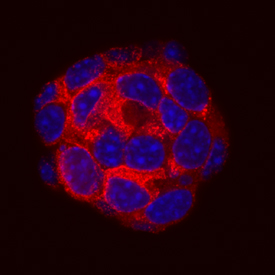Human/Mouse Proinsulin Biotinylated Antibody Summary
Phe25-Asn110
Accession # P01308
Applications
Please Note: Optimal dilutions should be determined by each laboratory for each application. General Protocols are available in the Technical Information section on our website.
Scientific Data
 View Larger
View Larger
Proinsulin in beta TC‑6 Mouse Cell Line. Proinsulin was detected in immersion fixed beta TC-6 mouse beta cell insulinoma cell line using Mouse Anti-Human/Mouse Proinsulin Biotinylated Monoclonal Antibody (Catalog # BAM13361) at 10 µg/mL for 3 hours at room temperature. Cells were stained using the NorthernLights™ 557-conjugated Streptavidin (red; Catalog # NL999) and counterstained with DAPI (blue). Specific staining was localized to cytoplasm. View our protocol for Fluorescent ICC Staining of Cells on Coverslips.
Reconstitution Calculator
Preparation and Storage
- 12 months from date of receipt, -20 to -70 °C as supplied.
- 1 month, 2 to 8 °C under sterile conditions after reconstitution.
- 6 months, -20 to -70 °C under sterile conditions after reconstitution.
Background: Proinsulin
Proinsulin is synthesized as a single chain, 110 amino acid (aa) preproprecursor that contains a 24 aa signal sequence and an 86 aa proinsulin propeptide. Following removal of the signal peptide, the proinsulin peptide undergoes further proteolysis to generate mature insulin, a 51 aa disulfide-linked dimer that consists of a 30 aa B chain (aa 25‑54) bound to a 21 aa A chain (aa 90‑110). The 34 aa intervening peptide (aa 55‑89) that connects the B and A chains is termed the C-peptide. Human proinsulin shares 84% and 80% aa sequence identity with rat and bovine proinsulin, respectively. Most of the sequence variation between species occurs in the region of the C‑peptide (1). This peptide generates a structural conformation that allows for the correct formation of the intrachain disulphide bonds (1). Insulin is a molecule that facilitates the cellular uptake of glucose. This is accomplished by regulating the appearance of membrane glucose transporters. Low insulin levels or lack of insulin are associated with type 2 and type 1 diabetes mellitus, respectively. These conditions are associated with an increased risk for microvascular complications such as retinopathy, nephropathy, and peripheral neuropathy (3). Proinsulin also circulates, but its physiologic role is less well understood. It does possess about 25% of the activity of mature insulin, but it would seem unlikely to be a natural substitute for insulin (4). In type 2 diabetes, an elevated proinsulin to insulin ratio in the circulation is a well-known abnormality (5‑9). Perhaps this abnormality represents either compromised proteolytic processing or a general inability to process increased levels of insulin precursor (5). In any event, proinsulin will stimulate amylin secretion by beta ‑cells, and amyloid formation in pancreatic islets that promotes decreased beta cell function (10). Studies also suggest that fasting serum proinsulin may be a better predictor of future type 2 diabetes than fasting insulin levels in obese children (11).
- Bell, G.I. et al. (1980) Nature 284:26.
- Barbetti, F. et al. (1990) J. Clin. Endocrinol. Metab. 71:164.
- Forst, T. et al. (2008) Exp. Diabetes Res. 2008:176245.
- Steffes, M.W. et al. (2003) Diabetes Care 26:832.
- Roder, M.E. et al. (1999) Diabetes Care 22:609.
- Porte, D. Jr. (1991) Diabetes 40:166.
- Gordon, P. et al. (1974) Diabetologia 34:483.
- Saad, M.F. et al. (1990) J. Clin. Endocrinol. Metab. 70:1247.
- Roder, M.E. et al. (1995) J. Clin. Endocrinol. Metab. 80:2359.
- Dworacka, M. et al. (2006) Int. J. Clin. Pharmacol. Ther. 44:14.
- Kamoda, T. et al. (2006) Diabetes Obes. Metab. 8:192.
Product Datasheets
Citation for Human/Mouse Proinsulin Biotinylated Antibody
R&D Systems personnel manually curate a database that contains references using R&D Systems products. The data collected includes not only links to publications in PubMed, but also provides information about sample types, species, and experimental conditions.
1 Citation: Showing 1 - 1
-
Modulation of Unfolded Protein Response Restores Survival and Function of beta-Cells Exposed to the Endocrine Disruptor Bisphenol A
Authors: LM Daian, G Tanko, AM Vacaru, L Ghila, S Chera, AM Vacaru
International Journal of Molecular Sciences, 2023-01-19;24(3):.
Species: Mouse
Sample Types: Whole Cells
Applications: ICC
FAQs
No product specific FAQs exist for this product, however you may
View all Antibody FAQsReviews for Human/Mouse Proinsulin Biotinylated Antibody
There are currently no reviews for this product. Be the first to review Human/Mouse Proinsulin Biotinylated Antibody and earn rewards!
Have you used Human/Mouse Proinsulin Biotinylated Antibody?
Submit a review and receive an Amazon gift card.
$25/€18/£15/$25CAN/¥75 Yuan/¥2500 Yen for a review with an image
$10/€7/£6/$10 CAD/¥70 Yuan/¥1110 Yen for a review without an image


